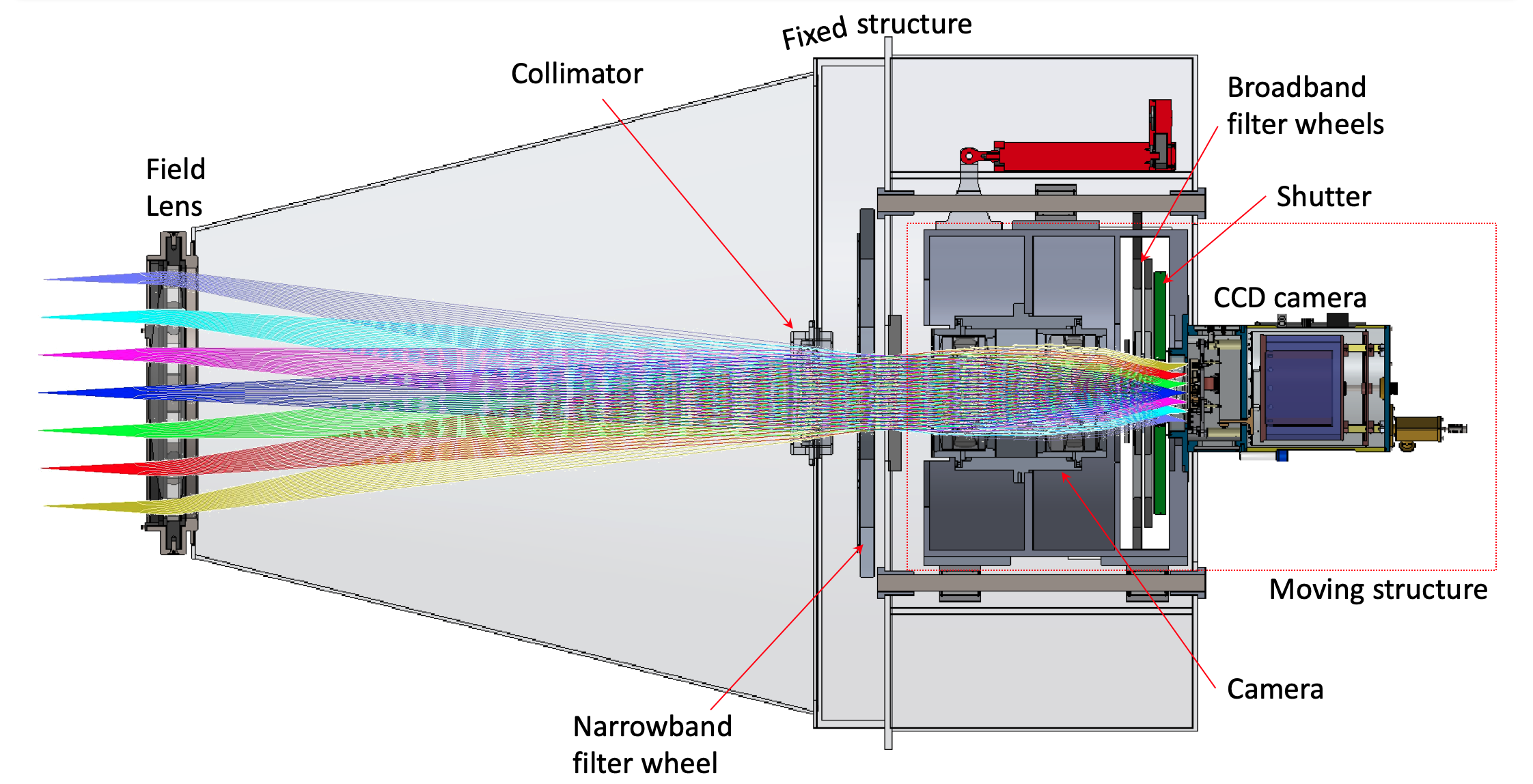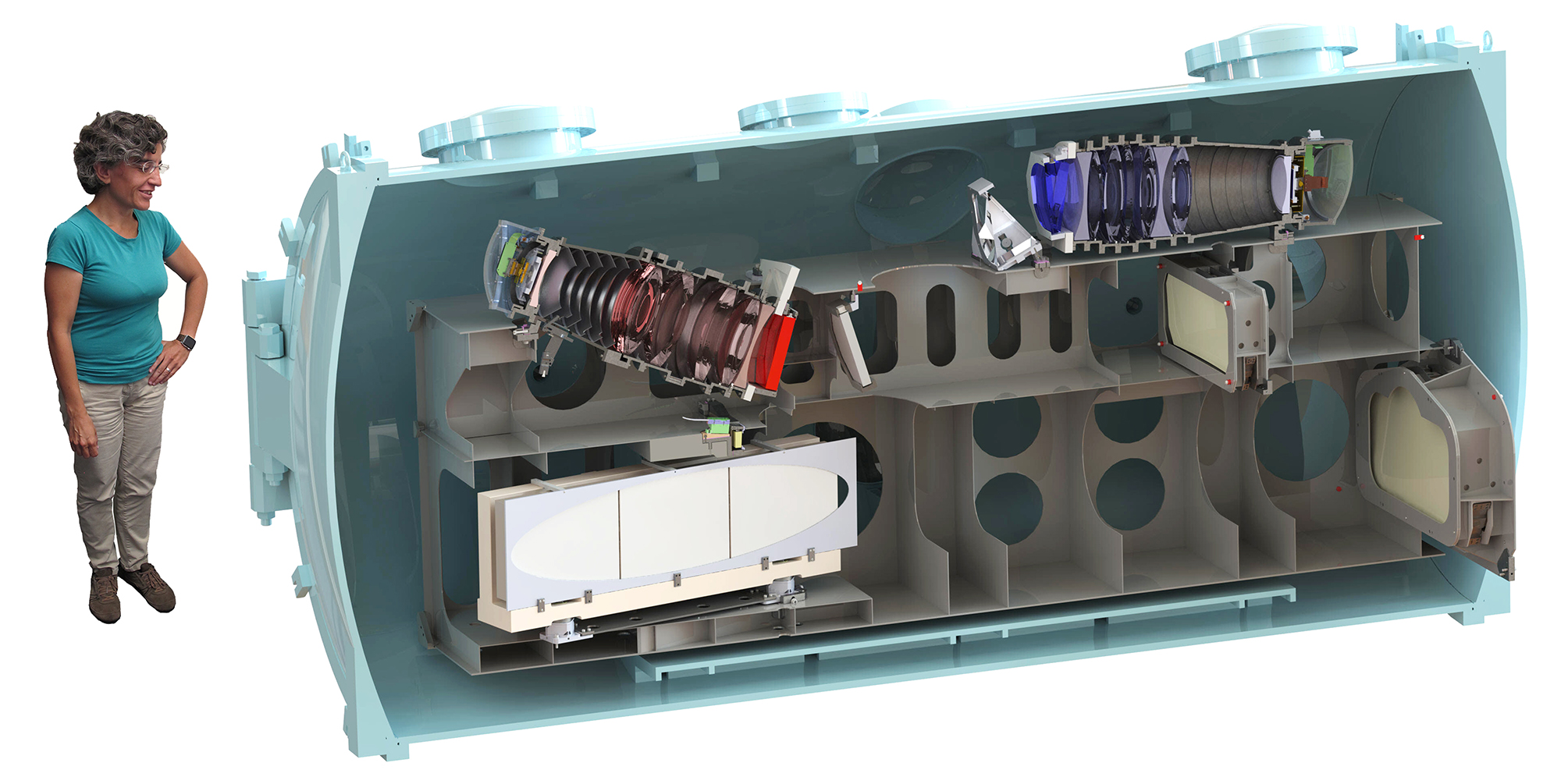WHAT IS SCIENCE ISNTRUMENTATION?
The set of instruments that analyze the light collected by a telescope is usually called "Instrumentation". For the light collected by a telescope to provide scientific information, it needs to be analyzed by an "instrument". This instrument can be an imager, polarimeter or, more commonly, a spectrograph. Spectrographs "scatter" light like a rainbow, but with very high sharpness. With this we can obtain important information about speed, age, temperature, mass, abundance of chemical elements and other parameters of the objects under study.
DISCOVER THE GMT INSTRUMENTATION SET:
ComCam - Commissioning Camera
The commissioning camera will be used to validate the Ground Layer Adaptive Optics (GLAO) performance of the GMT facility Adaptive Optics System. It is also needed for the initial alignment of the telescope and for verifying the natural seeing optical performance in the Direct Gregorian Narrow Field (DGNF) mode.
Science Goals
Commissioning – Alignment and image quality verification, Ground-layer AO performance verification
Science – Deep broadband imaging (e.g., stellar populations, galaxy morphology), Deep Narrow band imaging (e.g., planetary nebulae at 100 Mpc)
Technical Specifications
Wavelength range: 3,600 – 9,500 Å
Pixel Scale: 0.06 arcsec/pix
Distortion: < 0.6%
Image quality: ~0.10 arcsec FWHM
Field of view: 36 arcmin2
Read more here!
G-CLEF - GMT Consortium Large Earth Finder
The G-CLEF is a general-purpose visible echelle spectrograph that also provides precision radial velocity capabilities. G-CLEF will reside in a gravity invariant and temperature-controlled environment on the azimuth disk of the telescope. An optical and fiber relay system will transfer light from the telescope to G-CLEF and will scramble the light within each of the seven sub-apertures in the process. The instrument will support several observing modes with a range of spectral resolutions and input aperture sizes.
More detailed information can be found on the CfA G-CLEF webpage.
PI: Andrew Szentgyorgyi (SAO/Harvard)
Science Goals
Exoplanets – precise velocities, atmospheric properties
Stars – abundances, isotopes, and velocities
Dwarf galaxies – abundances, dark matter
Cosmology – chemical evolution, fine structure constant
For more details on the science goals, please visit the CfA G-CLEF science webpage.
Technical Specifications
Spectral resolutions: 19,000, 35,000, 108,000
Wavelength range: 3500 – 9500 Å
Velocity precision: <50 cm/s per observation; <10 cm/s over time
Modes: High throughput, Medium Resolution, High resolution, precision radial velocity, multi-object (w/ MANIFEST)
Field of View: 300 arcmin2 (with MANIFEST fiber system)
For more details on the technical specifications, please visit the CfA G-CLEF technology webpage.
Papers
SPIE Proc 8446-052. Szentgyorgyi, A. et al. (2012)
SPIE Proc 9147-78. Szentgyorgyi, A. et al. (2014)
A complete list of G-CLEF publications can be found on the CfA G-CLEF webpage.
Read more here!
GMACS - GMT VISIBLE MULTI-OBJECT SPECTROGRAPH
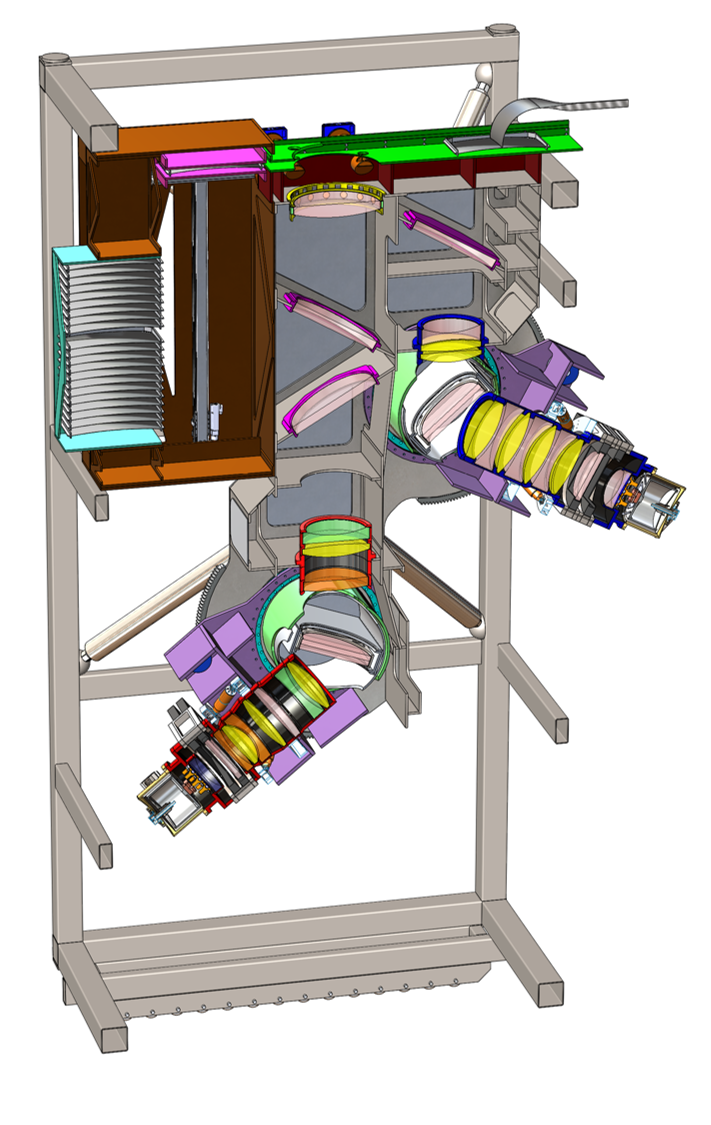
The GMT visible multi-object spectrograph (GMACS – GMT Multi-object Astronomical and Cosmological Spectrograph) covers a relatively wide field and uses wavelength multiplexing to deliver a large AΩ-λ combination. Dichroic mirrors feed cameras optimized over single octave bandpasses.The full instrument will deliver moderate resolution (R =1500 – 5000) spectroscopy over a large field of view from the near UV to very near-IR regions of the spectrum. The GMACS team is refining the concept for the instrument and considering trades between field of view, wavelength coverage, resolution and operating modes. The concept shown above, with two spatial and two wavelength channels, has been developed by a team at Texas A&M and Carnegie as part of the early conceptual design.
More detailed information can be found on the Texas A&M GMACS webpage.
PI: Darren DePoy & Jennifer Marshall (Texas A&M)
Science Goals
Distant galaxies – Lyα luminosity function at z < 6.5, chemical enrichment of ISM, redshift surveys
Nearby galaxies – chemical enrichment history, dark matter distribution, stellar populations and evolution, transient follow-up
Technical Specifications
Spectral resolution: 1,000 – 6,000
Field of view (diameter): 7.4 arcmin
Wavelength range: 3200 – 10000 Å
Multi-slit mask count: 24 masks with 50-100 slits/mask
Alternate input: 100s of fibers using MANIFEST
Field of view (MANIFEST): 300 arcmin2
Papers
SPIE 2018 papers and posters:
- GMACS Overview Paper
- Mechanical Design Paper, Mechanical Design Poster
- Optical Design Paper, Optical Design Poster
- Electrical Design Paper, Electrical Design Poster
- Systems Engineering Paper, Systems Engineering Poster
SPIE 2012 paper:
SPIE Proc 8446-058. DePoy D. L. et al.
Read more here!
MANIFEST - FACILITY FIBER OPTICS POSITIONER

The Many Instrument Fiber System (MANIFEST) is a facility fiber system. The GMT has an unusually large field of view for an ELT. While some of the proposed instruments use a significant portion of the field, none make full use of the 20´ diameter. MANIFEST provides a means to observe multiple targets over the entire field of view with one or more of the spectrographs, including GMACS and G-CLEF. The precise multiplexing gains vary for each spectrograph depending on the available slit length and type of fiber inputs employed. The MANIFEST concept uses “Starbugs” – self-motile fiber heads deployed on a glass plate. MANIFEST offers a means by which GMT can be optimized for high AΩ survey science without reimaging the full focal plane.
More information can be found on the AAO MANIFEST webpage.
PI: Lawrence / Colless (AAO-MQU) / (ANU)
Science Goals
Fiber feeding system to facility spectrographs
Galaxies – chemical composition, distribution, evolution, radial velocities, dark matter, distributions
Stars – kinematics, abundances
Planets – atmospheric chemistry
Intergalactic Medium – chemical composition, gas dynamics, ionization states
Technical Specifications
Field of view: 314 arcmin2
Wavelength range: 3,600 – 16,000 Å (optical and IR fibers)
Number of fibers: ~5,000
Positioning accuracy: 0.02 arcsec
Positioning time: <3 minutes
Instruments supported: GMACS, G-CLEF, future IR Multi-object spectrograph (simultaneously)
Papers
SPIE Proc 8446-289. Goodwin, M. et al.
Read more here!
GMTIFS - NEAR-IR IFU AND ADAPTIVE OPTICS IMAGER
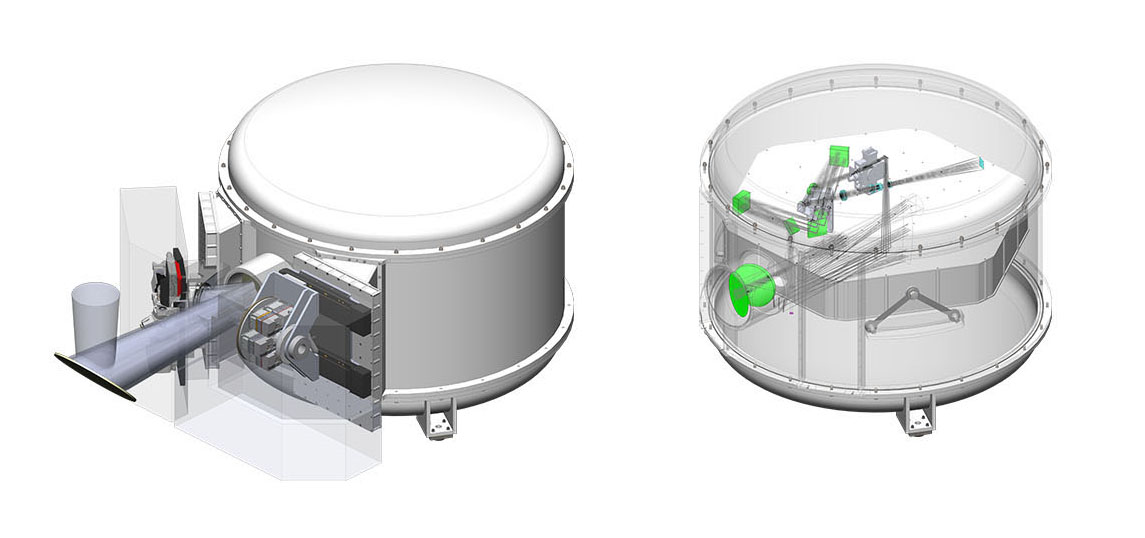 The GMT integral field spectrograph (GMTIFS) builds on the legacy of the NIFS instrument on Gemini. It uses an image slicing micro-mirror system to reformat the focal plane onto the detector. Spaxel scales from 8 to 50mas are provided and all feed an R = 5000 spectrograph that can cover any one of the J, H, or K-bands in a single setting. The instrument also has an imaging channel that will cover the laser tomography AO (LTAO) field while critically sampling the PSF in the J-band.
The GMT integral field spectrograph (GMTIFS) builds on the legacy of the NIFS instrument on Gemini. It uses an image slicing micro-mirror system to reformat the focal plane onto the detector. Spaxel scales from 8 to 50mas are provided and all feed an R = 5000 spectrograph that can cover any one of the J, H, or K-bands in a single setting. The instrument also has an imaging channel that will cover the laser tomography AO (LTAO) field while critically sampling the PSF in the J-band.
More detailed information can be found on the ANU GMTIFS webpage.
PI: Rob Sharp (ANU)
Science Goals
Young stars – star and planet formation processes
Nearby galaxies – chemical enrichment history
First galaxies – structure and assembly
Massive black holes – masses and physics of galaxy nuclei
Gamma ray bursts – intergalactic medium at z~7
Technical Specifications
Spectral resolutions: 5,000 and 10,000
Wavelength range: 0.9 – 2.5 μm
Spatial resolution (IFU): 6, 12, 25, or 50 mas
Field of view (IFU): ranging from 0.5”x0.25” to 4”x2”
Spatial resolution (Imager): 0.005 arcsec/ pix
Field of view (imager): 20 x 20 arcsec
Papers
SPIE Proc 8446-053. McGregor, P.J. et al.
Read more here!
GMTNIRS - IR ECHELLE SPECTROGRAPH
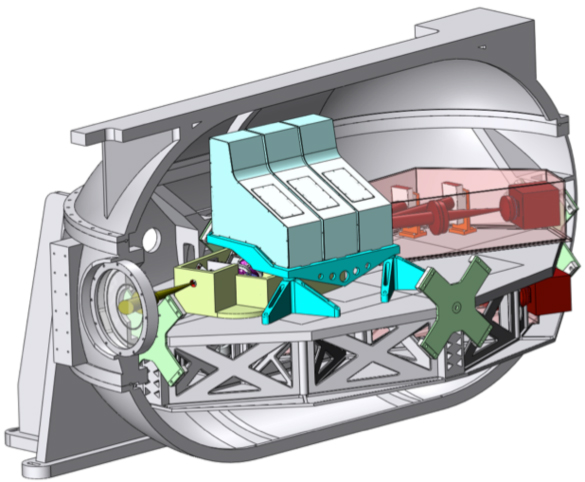 The GMT Near-IR spectrograph (GMTNIRS) is a 1.1 – 5.4 micron echelle optimized for studies of young stellar objects, debris disks, and protoplanetary systems. It will use Silicon immersion gratings to achieve high spectral resolution in a compact format. Using slits well matched to the diffraction-limited image size from a single segment, GMTNIRS will deliver R = 50 – 100k spectra over 5 (JHKLM) atmospheric windows in a single observation. This represents an enormous gain in observing efficiency compared to current spectrographs that sample only a fraction of a band in a single setting.
The GMT Near-IR spectrograph (GMTNIRS) is a 1.1 – 5.4 micron echelle optimized for studies of young stellar objects, debris disks, and protoplanetary systems. It will use Silicon immersion gratings to achieve high spectral resolution in a compact format. Using slits well matched to the diffraction-limited image size from a single segment, GMTNIRS will deliver R = 50 – 100k spectra over 5 (JHKLM) atmospheric windows in a single observation. This represents an enormous gain in observing efficiency compared to current spectrographs that sample only a fraction of a band in a single setting.
More detailed information can be found on the University of Texas at Austin GMTNIRS webpage.
PI: Dan Jaffe (The University of Texas at Austin)
Science Goals
Exoplanets – atmospheric chemistry, internal structure
Stars – formation of stars, disks, and planets, abundances
Nearby galaxies – chemical evolution history and current stellar composition
Distant galaxies – composition of universe in Lyα systems, abundances and evolution
Technical Specifications
Spectral resolution: 65,000 (JHK), 85,000 (LM)
Wavelength range: 1.1 – 5.4 μm
Slit length: 1.2 arcsec
Papers
SPIE Proc 7735. Lee, S. et al.
Read more here!
